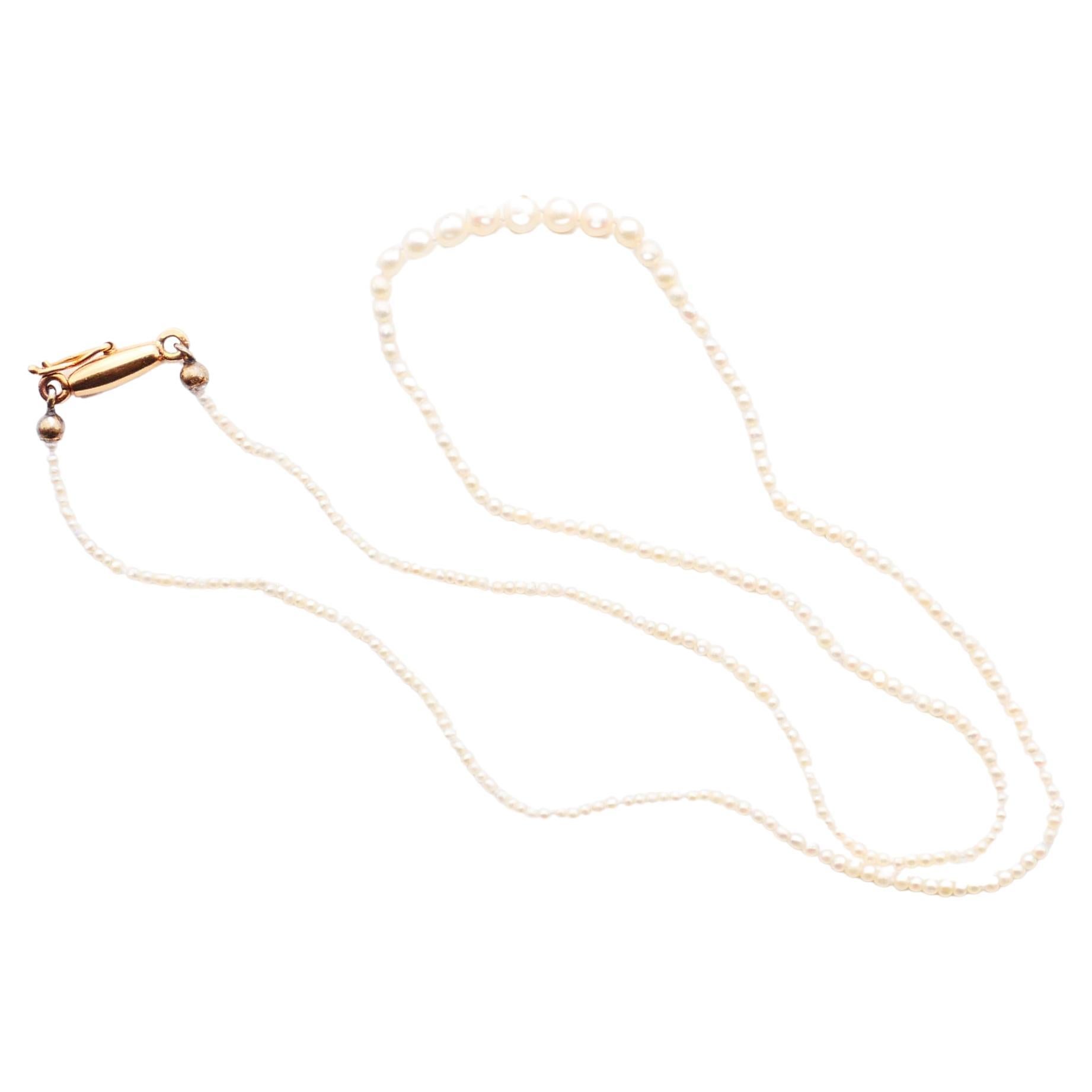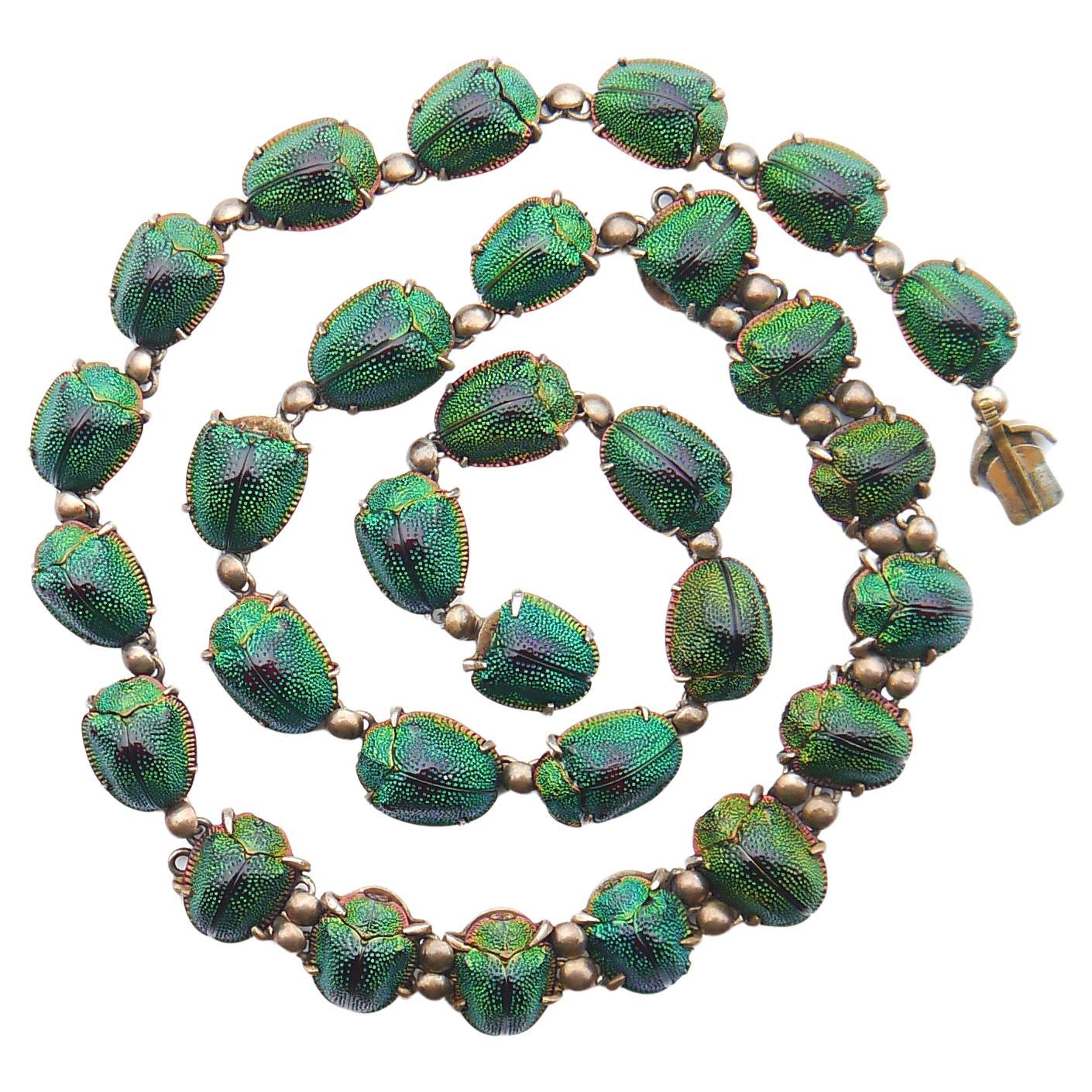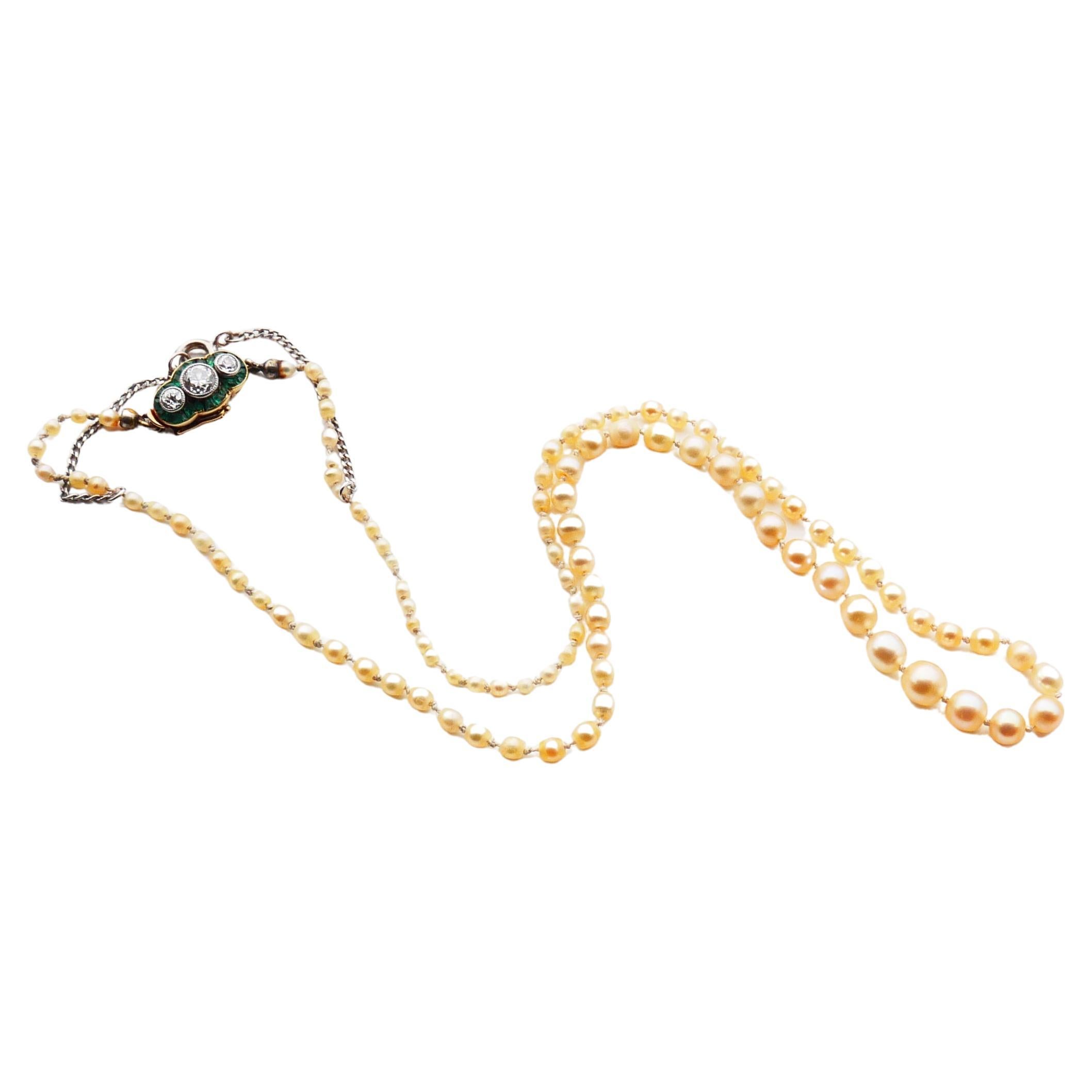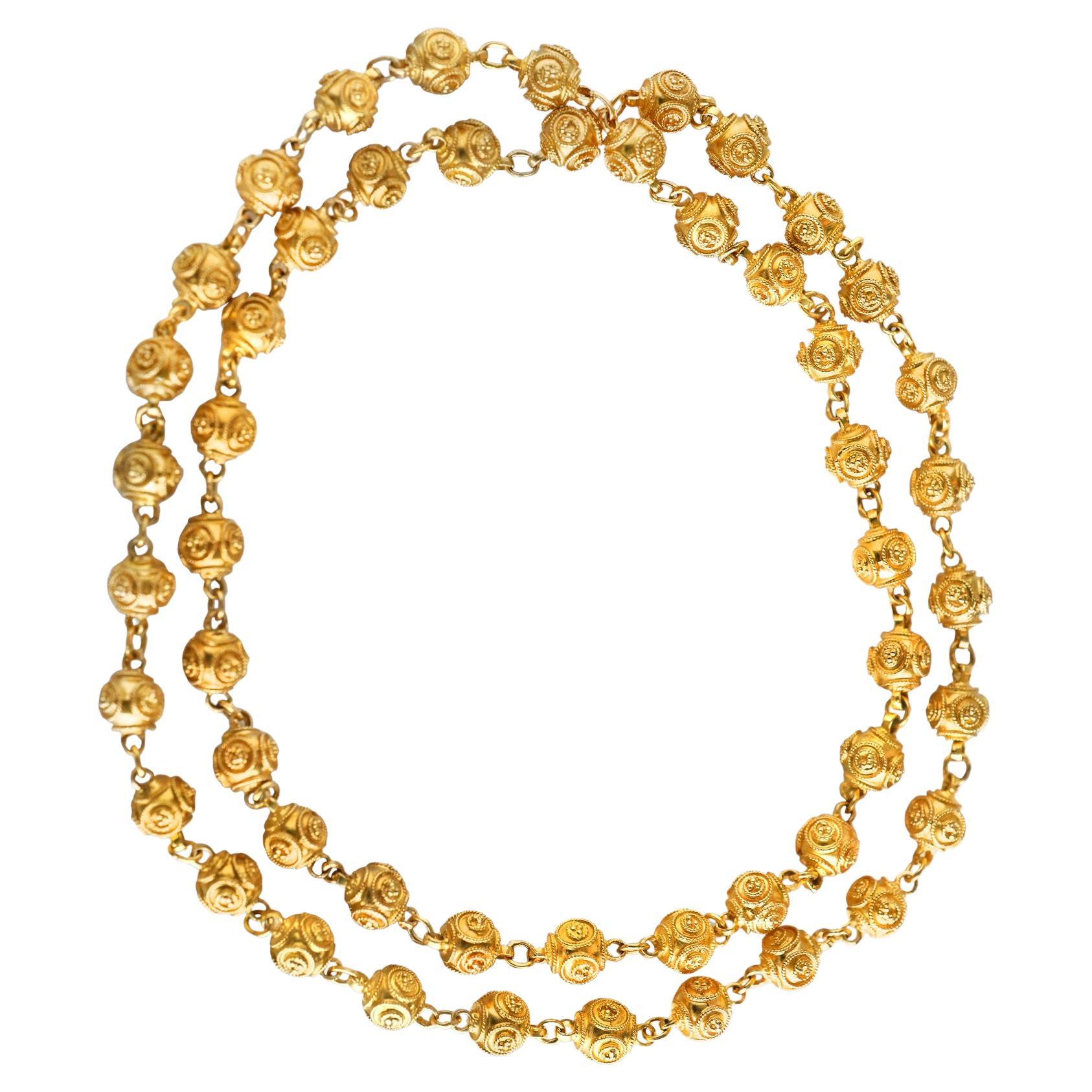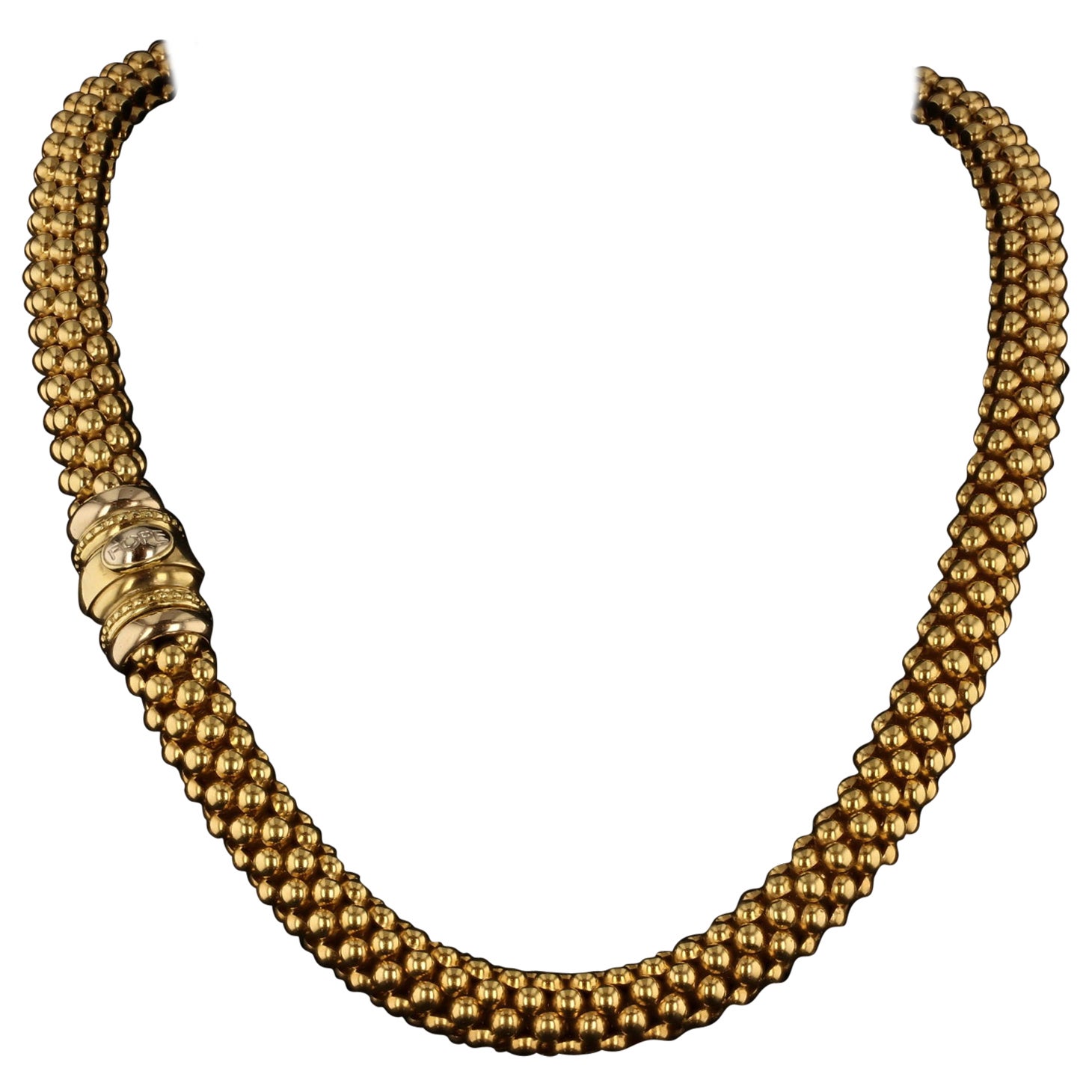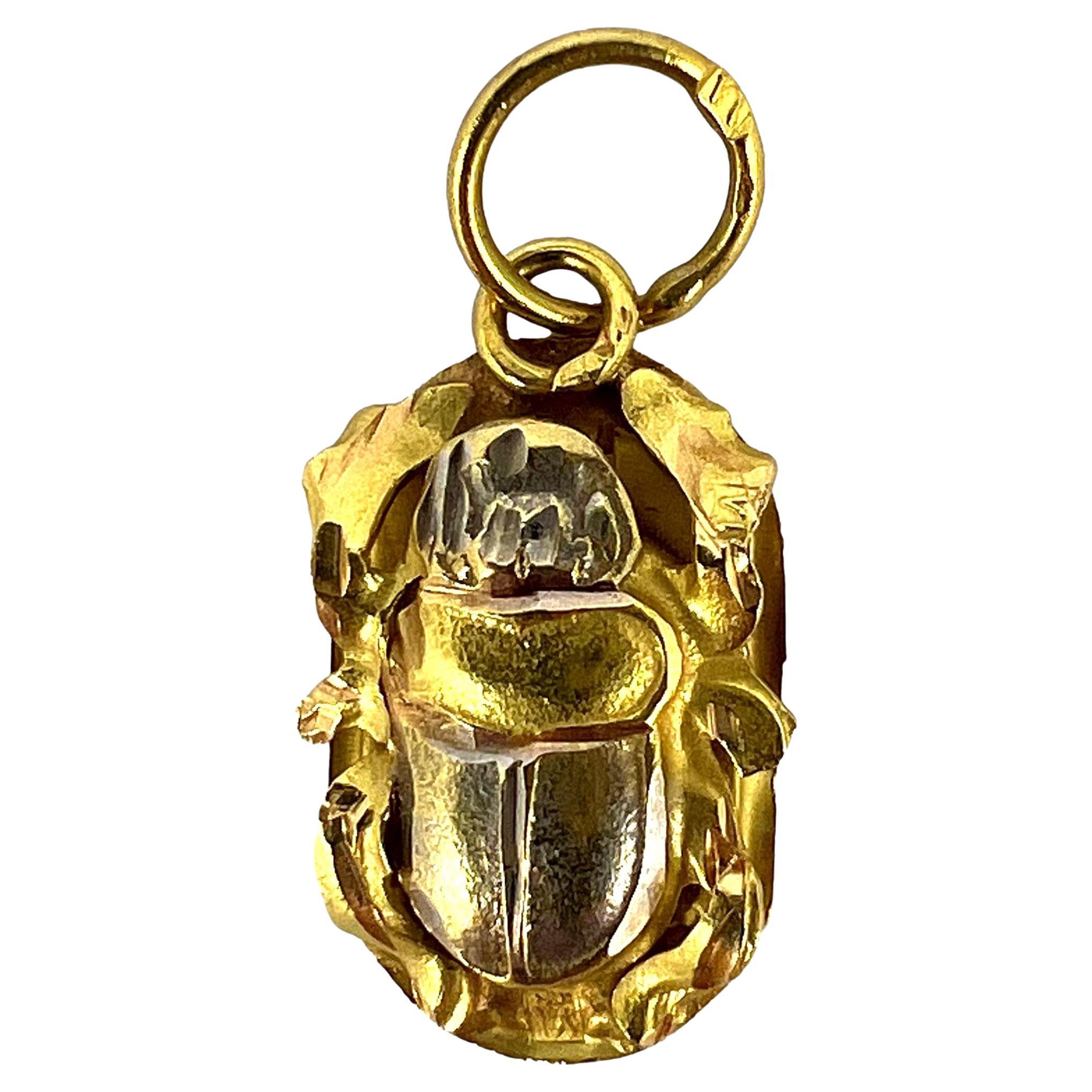Items Similar to 1786 -1567 BC Hyksos Scarabs Egyptian Revival Necklace 18K Gold /37.5cm/51gr
Want more images or videos?
Request additional images or videos from the seller
1 of 14
1786 -1567 BC Hyksos Scarabs Egyptian Revival Necklace 18K Gold /37.5cm/51gr
About the Item
This a unique opportunity to buy an extremely rare and strikingly unusual antique necklace, a fine example of Egyptian Revival jewelry composed of 14 genuine ca.1786 -1567 BC ancient Hyksos Egyptian / Middle Eastern Soapstone or Steatite Scarabs assembled /swivel set into solid 18K Yellow Gold frame between ca. 1800s- 1850s somewhere in Europe. All scarabs can be rotated around the axes. Each golden bezel was individually made to fit the specific dimensions of each beetle. The V-lock part and the security chain are made of Silver.
The length of the necklace is 37.5 cm / it's a chocker. To make it longer you will need to replace or extend the existing 18K Gold chains for longer ones.
Weight of the piece: 51 grams / of which about a half is a weight of 18K Gold metal parts.
Condition is fine used / as found - I didn't try to clean it. It seems that the scarabs are covered with tinted beeswax-like substance. All parts are securely set /attached to each- other. Ready to be used again.
Most of these or likely all of these beetles date approximately to the period called the Second Intermediate Period of Egypt ca.1650 -1550 BC when Ancient Egypt fell into disarray for a second time, between the end of the Middle Kingdom and the start of the New Kingdom. It is best known as the period when the Hyksos made their appearance in Egypt and whose reign comprised the Fifteenth dynasty.
These scarabs are Made of Steatite - a very unusual natural mineral that initially is rather soft ( Mohs hardness 1 ) and easy to carve on but it undergoes transformations when heated to temperatures of 1000–1200 °C turning into Enstatite and Cristobalite; in the Mohs scale, this corresponds to an increase in hardness from initial Mohs hardness 1 > to Mohs hardness level 5.5–6.5 and that makes it a very suitable material for making jewelry like these scarabs. This future of Steatite was known to ancients and they used this material in its initial naturally softer state to carve and shape the way they wanted to and would burn it in the oven when ready making it much harder. The scarabs would often undergo second heating to apply enamels of various colors or were painted with certain long-lasting natural dies - some beetles show reddish glaze or paint still present (note N. 9 and 10) , and two are black colored (N.3 and 11). Once these scarabs were a common form of "charm" which everyone could afford and easily wear strung on a cord on their person. Most scarabs were made for the living, both rich and the poor. The small magical object was believed imbued with particular protective powers that warded off evil and provided good things for the owner for this life and also for the next, particularly when sewn to mummy wrappings.
All scarabs in this set are one-of-a-kind genuine ancient pieces. All bottoms are flat and demonstrate the decorations - cartouches typical for Egyptian iconography that demonstrate the extraordinary skills of ancient carvers.
N1 : 15mm long,top part grinned off and mounted into the golden lock casing, showing great detailed carving of a goat or an antelope - very common Hyksos design.
N2 : 14 mm long, carved design of a hawk and two uraeii /cobras
N3 : 13 mm long, two "ankh" hieroglyphics representing life and swirled decor in the center, very typical Hyksos design
N4 : 16 mm long, carved design of a Goddess, likely Anubis, and a figure of a Dead in front of him.
N5 : 16 mm long, 11 deep-groove concentric circles with remnants of dark-colored enamel still visible, very typical Hyksos design
N6 : 18.5 mm long with the body of the scarab nicely carved and engraved with spiral scrolls, a very typical Hyksos design.
N7 : 22 mm long, three figures, one knelled
N8 : 18 mm long, a figure of a sitting pharaoh
N9 : 18 mm long, two "ankh" hieroglyphics representing life with probably the name of a pharaoh in between.
N10 : 18 mm long, body of the scarab nicely carved, cross-seal design on the other side.
N11 : 16 mm long, black, unknown design
N12 : 15 mm long. Very unusual piece I could not find any reference to any similar - there are three small scarabs in the shape of one (Egyptians divided their gods into trinities ), remnants of red paint, likely a carved name of a pharaoh on the reverse side.
The second unusual future of this scarab is that it was mounted differently with its body rotating around vertical axes, not horizontally like the rest of the scarabs.
N13: 13 mm long, very small-scale but complicated geometrical design. This beetle has a line with remnants of red paint going across its body - likely it was mounted on a ring in ancient times.
N14: 10 mm long, likely design of 2 carved fish.
Footnotes: No one can say for sure who were those Hyksos invaders, some suggest that they were Semitic people that came from the Levant (ie. Syria or Canaan). Others associate them with Hurrian-speaking people who came down from the ancient land of Mittani once located in the Armenian Highlands and northern Syria. They used advanced composite bows and body armor and were the first to use speedy and light-weight chariots in battles against their enemies. These futures allowed them to enslave Semitic tribes they encountered on the way and to defeat the Egyptian army taking control of the whole country for a short period of time.
To make it easier to imagine how old these pieces are one needs to mention that these beetles were made before Exodus when Mosses led Jews to the promised land of Israel in about the 16th century BC. Some sources state that The Hyksos invaders took over much of Lower Egypt around 1650 BC and founded a new capital at Avaris. Hyksos used Egyptian titles associated with traditional Egyptian kingship and took the Egyptian god Seth(Set)to represent their titular deity.
Some say that Judaism was Egyptian SET worship from the Hyksos Pharaohs who were expelled from Egypt. They were converted to Zoroastrian monotheism by the Persian Emperor Cyrus the Great who became the Messiah and ordered the building of the temple. He was making a buffer state for his Persian Empire
In the late 1700s, Napoleon’s military campaign in Northern Africa inspired a new global trend for exotic pieces with Egyptian Revivalist motifs. Europeans adored rich mysterious symbolism behind Egyptian-inspired jewelry. Scarabs in Ancient Egypt represent rebirth, resurrection, and the Eternal Soul. The Scarab is one of the most notable and recurring symbols in ancient Egyptian mythology and therefore became a common theme in Egyptian revival jewelry during this time.
>
Most of the items that we sell are not new at all if not stated otherwise. Accordingly, most of the items most often show some signs of use. We do our best to photograph and describe condition as accurately as possible if we notice something. There is no point in hiding anything or lying about the condition of used items that are at least several decades old..
Also presume that sometimes metal parts, stones or enamels ,etc. may show minor scratches, chips, micro-dents, minor deformations and other signs of wear and aging that we could miss to notice in description, unintentionally. .
If there are questions about an item, please email me before you buy it. I will note in the description any anomalies but also provide visual aid concerning condition though photographs, and these should be considered part of the description.
Most images of items listed were taken under natural light at daytime. We use modern high quality digital cameras and additional photo equipment for image processing. We upload high quality images that allow to see well the shapes, colors and flaws of very small stones . So look carefully before you buy anything. In reality some colors of materials involved may look a bit differently depending on light conditions, settings and functionality of your monitor and my camera. Your personal perception of colors and physiological conditions of your eyes may also affect the vision of the items. Gemstones may often look differently in different light and weather conditions and time of the day, both indoors and outdoors. Stones of the rings photographed alone may look a bit differently when on hand because your finger makes the back side of the stone closed and light no longer can go through and the color becomes different. Stones with closed backs may seem darker than stones with open backs. Such nuances of color perception do not give any excuse to claim item to be not as described.
Unfortunately Internet sales do not allow us to see the items in person before we get them by post. All listings on AdM contain detailed images and accurate descriptions of the items involved with all possible detailed information about colors and measurements involved. Minor color deviations may be possible. So If you want to be be absolutely sure about the colors or other qualities of the items that you want to buy - please buy at physical shops and avoid internet shops. Do not buy here.
CUSTOM WORK :
About Resizing: Resizing of rings can be done on request.The work will be done by experienced professional jeweler. Note: I will not be responsible for any physical/color changes that may occur as a result of heating of the stones during the process of resizing. I will not be responsible if in the process of resizing or customization any stone on the ring becomes loose , if any deformation occurs in general or if band of the ring changes shape or becomes deformed. Such misfortunes may occur very seldom, but cannot be ruled out when dealing with old jewelry for any sizing requires heating and change of the band's shape. Polishing of the band is always a final step of any resizing but machinery used for polishing causes vibration that old rings (with prongs for example ) often do not like at all.
So if you request resizing from me/my jeweler - do not forget about this disclaimer rule - I as a seller will not be responsible in case of any misfortune or damage that may occur during any customization or resizing work and there will be no refunds, cancellations or returns.
Once items have been sized, customized in any way or engraved they are not returnable. I can arrange alter certain things like bracelet or necklace lengths for an additional fee but once altered these items are not returnable. Please be certain of your purchase before requesting any customization.
CARE AND REPAIR:
Please note that nothing is immune to damage or wear after purchase if proper care is not taken and items may require maintenance at some point after purchase: stone tightening, band re-soldering, prong re-tipping, cleaning,etc. It is important to choose pieces that are appropriate for your lifestyle, especially important with an engagement ring or other piece that might be worn daily for an extended period of time; consider prongs, enamel, pearls,coral, turquoise and opal stones carefully as they may not work for daily or vigorous wear and may need special care.
It is recommended that rings be removed when performing manual labor such as gardening, heavy carpentry, working out, weightlifting or any other abnormally heavy activity. This particularly applies to pieces with enamel, pearls, opals, and delicate filigree but even diamonds can chip or stones fall out if proper care is not taken.
WEIGHT OF THE STONES
The cuts of the stones that you may see on many of the older jewelry items are usually of older mine or European and because of their deeper culets, off-round shapes and higher tables their weight is difficult to determine using the formulas for diamonds with a contemporary cut, therefore their approximate weight can only be estimated.
It is often difficult or impossible to get an accurate characteristics of the weight , color and nature of inclusions without removing the stones from the settings to be weighed and examined and doing that may damage the piece.
Please note: By industry standards appraiser's grades can often differ up to and including one full grade
Please note: All sizes and weights on set stones are approximate. Differences found under 1 mm are not considered appreciable.
About Certification : We can order GIA Certificates for items listed for additional payment upon request. Such service is expensive and takes time to complete. In case of Return or Cancellation any payments provided for custom Certification will not be refunded!
>
- Metal:
- Weight:51 g
- Dimensions:Length: 14.77 in (375 mm)
- Style:
- Place of Origin:
- Period:
- Date of Manufacture:Unknown
- Condition:Wear consistent with age and use. Condition is fine used / as found - I didn't try to clean it. It seems that the scarabs are covered with tinted beeswax-like substance. All parts are securely set /attached to each- other. Ready to be used again.
- Seller Location:SE
- Reference Number:
About the Seller
New to 1stDibs
Joined in the past six months.
No Reviews Yet
Vetted Seller
These experienced sellers undergo a comprehensive evaluation by our team of in-house experts.
Established in 2009
1stDibs seller since 2024
13 sales on 1stDibs
Typical response time: 5 hours
- ShippingRetrieving quote...Ships From: Malmo, Sweden
- Return PolicyA return for this item may be initiated within 3 days of delivery.
More From This SellerView All
- Antique Necklace Natural Seed Pearls solid 18K Gold / 37cm/ 1.8 grLocated in SEAntique,ca late 18th - early 19th century hand-made necklace, Egyptian revival styled or could be used for ceremonial or religious purposes. A linked chain with repeating floral pat...Category
Antique Early 1900s European Art Nouveau Beaded Necklaces
MaterialsPearl, 18k Gold
- 1889 Nordic Necklace Egyptian Revival 30 Scarab Beetle Gilt Silver / 50cm/ 27grLocated in SERare and very unusual piece of Egyptian - revival styled necklace with 30 genuine emerald Green Scarab Beetles set into gilt Silver frames. These shimmering Tortoise beetles once were the Victorian times' species of choice to stand in for genuine Scarabs...Category
Antique 1880s Swedish Egyptian Revival Pendant Necklaces
MaterialsSilver, Gold-filled
- Antique Necklace Natural Pearls Diamonds Emeralds solid 18K Gold /40cm/ 5.6grLocated in SEFine ca. early XX cent. Necklace featuring a beautiful set of 99 gradually sized natural Pearls complemented with original V-lock with safety clutch in solid 18K Orange Gold and Whit...Category
Antique Early 1900s European Art Nouveau Beaded Necklaces
MaterialsEmerald, Diamond, Natural Pearl, 18k Gold
- Antique Chineese Bracelet Jade Carnelian Giilt Silver /51grLocated in SEOld beautiful Chinese bracelet of the finest quality. There are 3 large Gilt Silver links made of fine-meshed Silver with multiple filigree elements soldered on. Large bezel set nat...Category
Vintage 1920s Chinese Arts and Crafts Bangles
MaterialsCarnelian, Jade, Silver, Gold-filled
- Antique Bohemian Bangle Bracelet 251 Garnets Granat Silver / 51grLocated in SEHandmade in Austria / Hungary or Bohemian bracelet, circa 1850 - early 1900s. A great example of an old Austro-Hungarian jewelry-making School. Deep rich red Bohemian rose cut Pyrop...Category
Antique Early 1900s Austrian Art Nouveau Bangles
MaterialsGarnet, Silver
- 1841 Nordic Necklace solid 18K Gold /44.5cm/4.5grLocated in SEAntique 18K Yellow Gold Swedish necklace with chained links, hallmarked 18K, unknown maker marks, city of Stockholm. Date hallmarks: L4 / made in 1841. Finest Used condition. All pa...Category
Antique 1840s Swedish Egyptian Revival Link Necklaces
Materials18k Gold
You May Also Like
- 18K Yellow Gold Bead Etruscan Revival NecklaceLocated in West Palm Beach, FL18K Solid Gold Ball Etruscan Revival Necklace. Unique design links 51 yellow gold balls together in an oval spring ring with no open clasp. Gold ball dimensions: 7.48 mm long x 9 mm ...Category
Vintage 1980s European Etruscan Revival Beaded Necklaces
MaterialsGold, Yellow Gold, 18k Gold
- Fope Italian Chunky Tubular Priofili 18K Gold 83.80 gr. Woven NecklaceBy FopeLocated in Newton, MAThis Italian made necklace by Fope is offered by Alex & Co. The chunky bold statement 18K yellow gold necklace features flexible rows of interlocking beads with a rounded decorative twist plunger clasp. The necklace weighs 83.80 grams and measures 16.50 inches long (9.5mm wide). The piece is hallmarked "FOPE" FOPE has its roots within the goldsmithing traditions of Italy, which has its historical and manufacturing center in the city of Vicenza. Umberto Cazzola opened the first FOPE workshop in 1929. In the same pioneering spirit, his son Odino transformed this workshop into a state-of-the-art factory and invented adjustable metal watch bracelets, while nephews Umberto and Ines created the iconic Novecento mesh and patented Flex’it technology. The 4th generation, with Giulia, reached international success; the family business is now listed on the Milan stock exchange and is today one of the most well-known and popular fine jewellery...Category
20th Century Italian Modern Beaded Necklaces
Materials18k Gold, Yellow Gold
- Egyptian Scarab 18K Yellow White Gold Charm PendantLocated in London, GBAn Egyptian 18 karat (18K) yellow and white gold charm pendant designed as the protective amulet of an Egyptian scarab, with a relief of a scarab beetle holding up the sun to the rev...Category
20th Century Egyptian Pendant Necklaces
MaterialsGold, 18k Gold, White Gold, Yellow Gold
- Yellow Gold Akoya Pearl Knotted Strand Necklace 37" - 18kLocated in Greensboro, NCMetal Content: 18k Yellow Gold Stone Information Akoya Pearls Color: Cream Size: 6.6mm - 6.8mm (7.9mm clasp) Style: Knotted Strand Fastening Type: Fishhook Clasp with Safety Bar M...Category
21st Century and Contemporary Beaded Necklaces
MaterialsPearl, 18k Gold, Yellow Gold
- Egyptian Revival King Tut Khepri Scarab Necklace 18Kt Gold with Carved GemstonesLocated in Miami, FLAn Egyptian revival king Tut Khepri Scarab necklace Beautiful colorful piece made with Egyptian motifs from the ancient kingdom of the Pharaohs. The dominant part is the figure of the sacred scarab with the feathers of the god Khepri flanked by two minor scarabs and two lotus flower symbols. This magnifique piece has been carefully crafted in solid yellow gold of 18 karats with high polished finish and accented with applications of enamel, fitted with a lobster security lock. Khepri, is the god of sunrise connected to the scarab beetle. Young dung beetles, having been laid as eggs within the dung ball, emerge from it fully formed and thus were considered to have been created from nothingness. Egyptians believed that each day the sun was also reborn or created from nothing. In the same way that the beetle pushes large balls of dung along the ground, Khepri moved the newly-born sun across the sky. Khepri was a solar deity and thus connected to the rising sun and the mythical creation of the world. The god and the scarab beetle represent creation and rebirth. Scarab originated in Ancient Egypt. A scarab is shaped like a dung beetle. There is a head, wing case, and legs. It is sometimes rounded and sometimes flat. The scarab was associated with the god Khepri who was the god or rebirth, creation, and the sun. Dung beetles were the earthly personification of Khepri as they would lay their eggs in balls of dung and then roll the dung balls all around until the eggs hatched. Early hieroglyphics depict Khepri as a scarab holding up the sun. There were hundreds of memorial scarabs created to memorialize Amenhotep III’s deeds. These included the bull hunt scarab which symbolizes strength and victory over chaos. Later, around 2000 BCE the scarab was used in jewelry and as seals. The amulets were worn as protection against the dangers of this world and the afterlife. The scarab represented the sun god Ra that rolled across the sky each day. Between the 16th and 11th- century heart scarabs...Category
Late 20th Century Egyptian Egyptian Revival Link Necklaces
MaterialsCoral, Lapis Lazuli, Turquoise, Yellow Gold, Enamel, Gold, 18k Gold
- Art Deco Egyptian Revival Scarab Pendant Necklace Sterling SilverLocated in New York, NYThis is a very rare antique Art Deco Egyptian Revival Scarab Pendant Necklace in Sterling Silver with a stunning Link Chain. The necklace is hallmarked Sterling JAR or JAD. The neck...Category
20th Century Unknown Egyptian Revival Pendant Necklaces
MaterialsSilver, Sterling Silver
